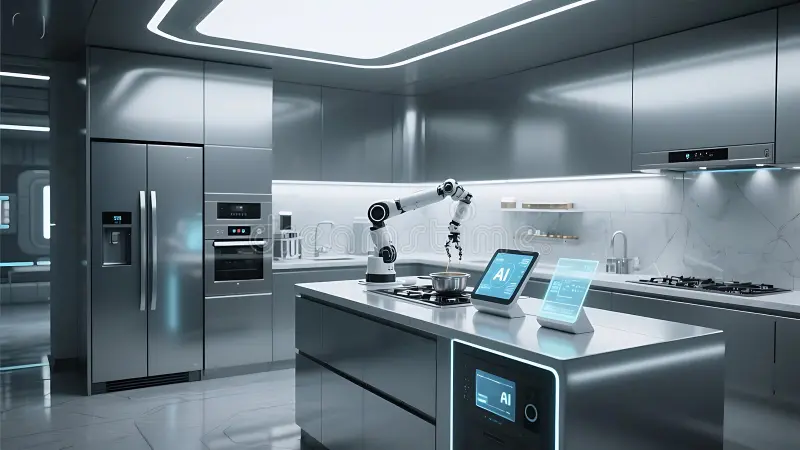The kitchen has always been the heart of the home — a place for cooking, sharing meals, and making memories. But in the age of technology, it’s becoming much more than that. The smart kitchen represents a perfect blend of innovation, efficiency, and convenience. From connected appliances to AI-driven assistants, the modern kitchen is evolving into a space where every task is faster, cleaner, and more enjoyable.
What Is a Smart Kitchen?
A smart kitchen is a cooking space equipped with technology that enhances functionality and convenience. It uses smart appliances, sensors, and connected devices that can be controlled via smartphone, voice commands, or automation. These kitchens are designed to save time, reduce waste, and improve cooking accuracy — all while making everyday tasks easier.
Imagine preheating your oven from your phone, asking Alexa to brew your morning coffee, or having your refrigerator alert you when the milk is about to expire. That’s the power of smart kitchen technology.
Key Features of a Smart Kitchen
Connected Appliances: Smart ovens, refrigerators, dishwashers, and microwaves can connect to Wi-Fi, allowing you to control them remotely. For example, a smart oven can send alerts when your food is ready or automatically adjust cooking temperatures for the perfect roast.
Voice-Activated Controls: Integration with assistants like Amazon Alexa, Google Assistant, or Apple HomeKit allows you to control lighting, timers, and appliances using simple voice commands — no buttons needed.
Energy Efficiency: Smart kitchens use advanced sensors to optimize energy use. For instance, induction cooktops heat only the pan surface, minimizing wasted energy.
AI and Automation: AI-enabled devices learn your habits and make recommendations — from suggesting recipes based on what’s in your fridge to adjusting the coffee machine to your favorite brew time.
Smart Kitchen Touchless Faucet – A Hygienic Upgrade
One of the most practical and hygienic innovations in the modern kitchen is the smart touchless faucet. These faucets use motion sensors or voice commands to start and stop water flow without needing to touch the handle.
Here’s why they’re becoming a must-have in every smart kitchen:
- Hands-Free Convenience: Whether your hands are full of dough, raw chicken, or dishes, you can easily wave your hand or say a voice command to turn on the water — perfect for multitasking.
- Improved Hygiene: Reducing physical contact minimizes the spread of germs and bacteria, making it ideal for maintaining a cleaner cooking space.
- Water Conservation: Many smart faucets are equipped with flow sensors that automatically stop water when not in use, saving gallons over time.
- Smart Integration: Some models connect to smart home systems like Alexa or Google Assistant, allowing you to control temperature and flow using voice commands — “Alexa, fill the pot with two cups of water.”
Touchless faucets not only make your kitchen more modern but also more sustainable and health-conscious.
Popular Smart Kitchen Gadgets
Here are a few other devices transforming everyday cooking:
- Smart Refrigerators: With built-in cameras and screens, they track expiration dates, suggest recipes, and even let you view inside the fridge via your phone.
- Smart Ovens and Air Fryers: Preheat remotely, monitor cooking progress, and get notifications when your food is done.
- Smart Scales and Measuring Devices: These connect to apps that guide you through recipes with exact measurements and nutritional data.
- Smart Lighting: Motion-sensing or voice-controlled lighting adds convenience and ambiance to your cooking experience.
Benefits of Having a Smart Kitchen
Time-Saving: Automation and remote control reduce manual work and make meal prep more efficient.
Healthier Cooking: Smart appliances track ingredients and portion sizes, promoting healthier eating habits.
Cost Efficiency: Energy-efficient appliances help cut utility bills over time.
Safety: Smart sensors can detect leaks, gas, or smoke and send instant alerts to your phone.
Eco-Friendly: Smart devices optimize water and electricity use, promoting sustainability.
Building Your Own Smart Kitchen
You don’t need to remodel your entire kitchen to make it “smart.” You can start small and upgrade gradually. Begin with a smart speaker or display like Alexa or Google Nest. Add smart bulbs or plugs for lighting and appliance control. Upgrade to a smart touchless faucet or Wi-Fi-enabled coffee maker. Gradually integrate smart appliances like refrigerators, ovens, or dishwashers.
The key is to choose products that work well together and align with your cooking habits.
The Future of Cooking
As AI and IoT (Internet of Things) continue to advance, the kitchen of the future will become even smarter. We’ll see more predictive cooking, automated meal planning, and integrated health tracking, where your kitchen works seamlessly with your lifestyle.
The smart kitchen isn’t just about gadgets — it’s about creating a connected, intuitive environment that helps you live better. Whether it’s a simple touchless faucet or a fully automated cooking system, each innovation brings us one step closer to effortless, sustainable, and enjoyable living.

